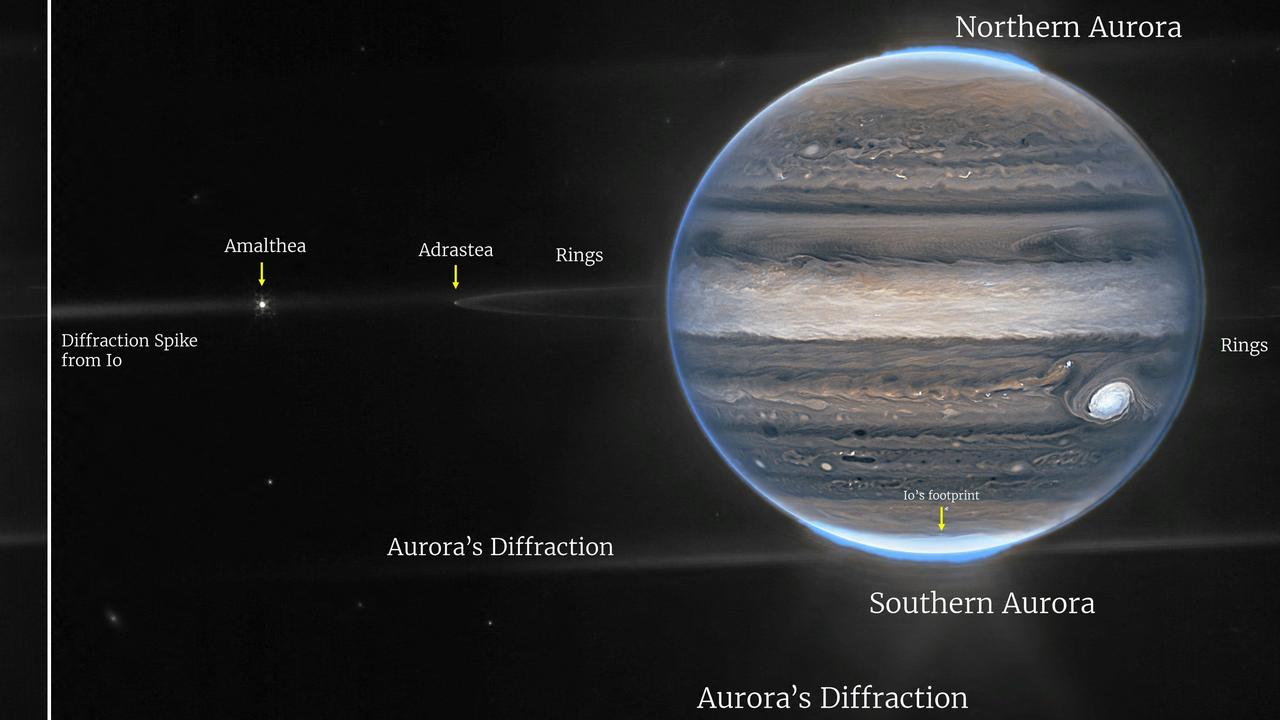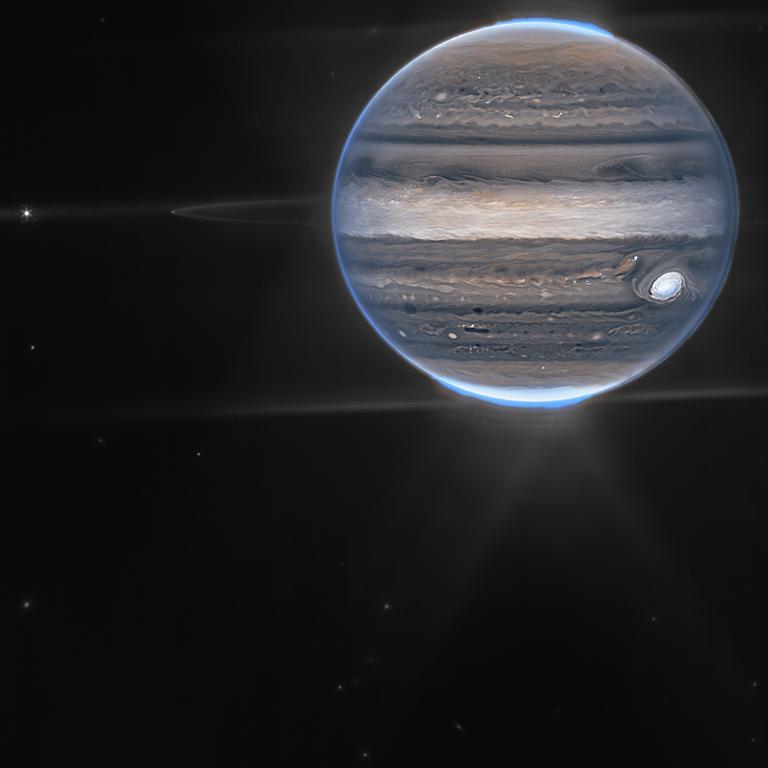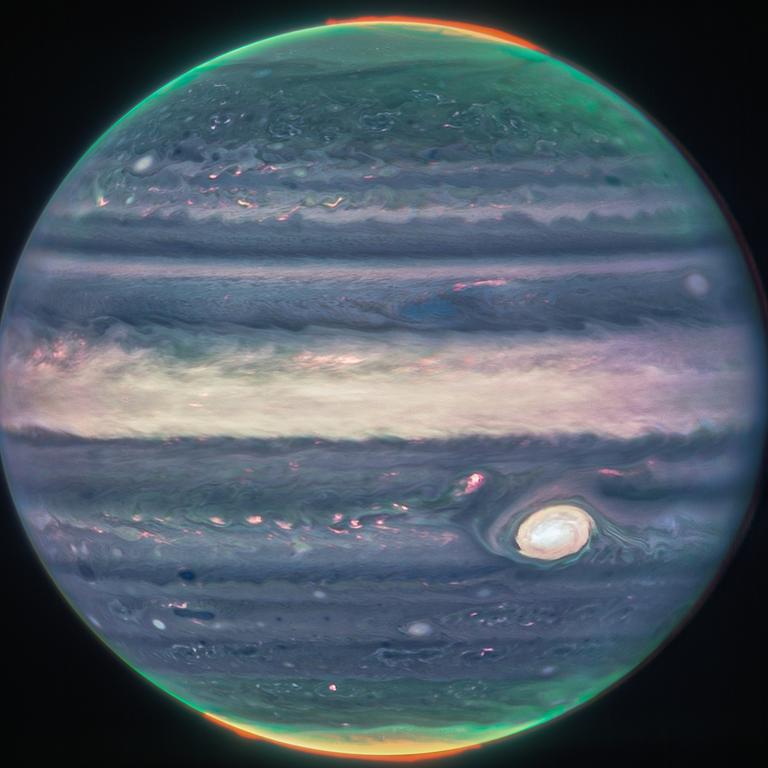Space telescope captures images of solar system’s biggest planet
NASA’s James Webb Space Telescope keeps dishing up stunning surprises from space as the latest shots pull focus to planet Jupiter and its rings, moons and auroras at north and south poles

READING LEVEL: GREEN
NASA’s James Webb Space Telescope has captured stunning images of the planet Jupiter showing two tiny moons, faint rings and auroras* at the northern and southern poles.
“We hadn’t really expected it to be this good, to be honest,” said University of California planetary astronomer* Professor Imke de Pater.
“It’s really remarkable that we can see details on Jupiter together with its rings, tiny satellites*, and even galaxies* in one image,” she said.

Professor De Pater headed the observations of Jupiter, the largest planet in our solar system, with Paris Observatory* Professor Thierry Fouchet.
The composite* images were taken with the observatory’s Near-Infrared* Camera (NIRCam) and were artificially coloured because infra-red light is not visible to the human eye.
The auroras above the northern and southern poles of Jupiter have been mapped in redder colours, while the Great Red Spot, a storm bigger than Earth, appears white.
One image shows Jupiter’s faint rings and its moons Amalthea and Adrastea.

Launched in December 2021 from French Guiana on an Ariane 5 rocket, Webb is orbiting* the sun at a distance of 1.6 million km from Earth, in a region of space called the second Lagrange point.
It took the spacecraft almost a month to reach the region, where it remains in a fixed position behind the Earth and the sun to give it a clear view of the cosmos*.
The Webb telescope is an international collaboration* between US space agency NASA, the European Space Agency and the Canadian Space Agency, involving more than 10,000 people.
GLOSSARY
- auroras: light displays caused by tiny particles from the sun interacting with a planet’s magnetic field
- astronomer: scientist who studies the stars, planets, and other natural objects in space
- satellite: moon, planet or machine that orbits a planet or star
- galaxies: huge collections of gas, dust, and billions of stars and their solar systems
- composite: when several different elements are put together to create a whole
- infra-red: outside visible spectrum, type of light that feels warm but cannot be seen
- orbiting: path taken by one body circling around another body
- cosmos: the universe considered as a system with an order and pattern
- collaboration: working together with other people or organisations to achieve something
EXTRA READING
Cartwheel Galaxy snaps have space fans in a spin
NASA shows off amazing new cosmic views
Fiery planet burns around sun-like star
QUICK QUIZ
- How many tiny moons have been captured in the Webb images of Jupiter?
- Why were the composite images artificially coloured?
- What is the Great Red Spot and what is it larger than?
- How far from Earth is the Webb telescope’s orbit?
- Why is the telescope in a fixed position behind planet Earth and the sun?
LISTEN TO THIS STORY
CLASSROOM ACTIVITIES
1. Name the auroras
Think of and write down the perfect names for the two auroras that have been seen above the north and south poles of Jupiter. Can you also think of a better name for the Great Red Spot? Write reasons why your three new names should be used.
Time: allow 15 minutes to complete this activity
Curriculum Links: English; Personal and Social Capability
2. Extension
If you could send the James Webb Space Telescope to any other part of our solar system, including another planet, where would you send it? Create a poster or write a letter to convince NASA to send it there.
Time: allow 30 minutes to complete this activity
Curriculum Links: English; Science
VCOP ACTIVITY
What happens next?
Imagine this story is part of an animated series made up of three cartoons. The three cartoons tell the complete story and this article is only Part 1. Think about what the rest of the story could be and draw the next two cartoons that tell the story.
Time: allow 30 minutes to complete this activity
Curriculum Links: English; Visual Arts; Visual Communication Design; Critical and Creative Thinking

